I feel the weight of the water pressing against me, and my feet sink deeper into the muddy wetland bottom with each step. Frogs croak, birds chirp in the trees, and dragonflies zoom around my ears, but I don’t have time to watch the wildlife around me. I volunteered to help trap turtles, and the mud, waders, and heavy poles I’m carrying to anchor the net trap make the morning an adventure.
I am one of many volunteers helping Vic Bogosian, Department of Conservation wildlife biologist and manager of Eagle Bluffs Conservation Area (south of Columbia), with his turtle trapping research project. Most management activities at Eagle Bluffs Conservation Area (CA) are focused on other animal residents, but a life-long passion for herpetology inspired Vic to study these unique creatures.
CATCH, TAG, RELEASE
From April to September, Vic traps turtles to collect population information. To help him with this endeavor, members of the community make their way through mud, weeds, and water to set traps and mark turtles. It’s a varied group: Girl Scouts, members of the Missouri Master Naturalists program, students from the University of Missouri Student Chapter of the Wildlife Society, the University of Missouri Herpetological Society, the Conservation Honors program at the University of Missouri-Columbia, and anyone interested in conservation. Trapping is difficult, sweaty work in the summer, and volunteers often leave dirty and exhausted, but all are excited by the opportunity to handle and observe these animals.
“Little did I know what an educational opportunity this was going to be,” says Chris Egbert, a regular turtle trapping volunteer and a Missouri Master Naturalist of the Boone’s Lick chapter. “I have marveled at Vic’s skill in working with the different types of volunteers working on this project.”
ALL-SPECIES MANAGEMENT
As manager of Eagle Bluffs CA, Vic makes decisions that help keep conditions ideal for migratory bird populations. However, it is his responsibility to take all wildlife species on the area into consideration. Similar to migratory birds, aquatic turtles need access to appropriate water levels, temperature, food, and vegetation for cover. The goal of his turtle trapping program is to see how his management decisions affect turtles, and how to make beneficial decisions for them.
Turtles are complex creatures. They feed on a variety of foods including aquatic plants, insects, snails, crayfish, and dead animals. Turtles can vary widely in appearance based on species. Their shells, which are a permanent part of their body and a source of protection from their environment, can be soft or hard, and either round or an elongated oval shape. Although the color of their upper shell (called the carapace) usually helps them to blend in the murky wetlands bottom, on many species the lower shell (called the plastron) can have patterns full of red, yellow, and black designs.
The most fearsome of the turtle species found at the area is the common snapping turtle. These animals can weigh up to 35 pounds, and can easily snap up birds, small mammals, and other aquatic reptiles with their strong jaws. Red-eared sliders are the most common turtle at Eagle Bluffs CA. There are also painted turtles and false map turtles. A less-common aquatic turtle is the spiny softshell, which has a leather shell instead of a hard, bony one. The three-toed box turtle is found at Eagle Bluffs CA, but that land-dweller is not caught in the hoop traps. Species of turtles on other conservation areas around the state vary, so other managers have different challenges.
THE VOLUNTEER EXPERIENCE
Turtle trapping at Eagle Bluffs during the summer months is hot and sticky work. Vic sends emails to volunteers notifying them of turtle trapping dates and always reminds them to “wear clothes you don’t care about.” He then takes groups out in the wetlands area to either place traps or to check traps, mark turtles that were caught, and then release them back into the area. This gives him a better idea about where turtle populations are concentrated.
To set traps, volunteers travel deep into the wetland area and wade into a pool of murky, muddy water. The traps, called single-throated hoop nets, are then strung between two poles and hammered into the wetland’s bottom to keep them from falling over. Volunteers place the traps so they do not sag or sink under the surface of the water. If the trap is completely submerged, there is a risk that captured turtles will drown due to lack of access to air. The traps are then baited with Asian carp provided by the Conservation Department’s Fisheries Division and the U.S. Geological Survey’s Columbia Environmental Research Center.
Once successfully placed in the water, the traps are left overnight and checked early the next morning. As turtles are removed from the trap, volunteers record each animal’s gender, species, trap location, and any other distinguishing characteristics, and then they mark individuals by drilling holes along the outer edge of the turtle’s shell (a common practice among herpetologists). The divisions along the shell (called scutes) are arranged the same way on most turtle species. Since holes are drilled in a consistent pattern along these divisions, there is a uniform numbering system for most of the turtles captured. This makes it easier to record information about the turtles because each turtle has an identifying number. Only snapping turtles and softshells get marked differently. Due to their size, shell type, and aggressive nature, it is safer for both the turtle and the researcher to mark them using a passive integrated transponder, or PIT tag. These tags are the same as those injected into family pets to help return them if they get lost. A coded tag is injected into the turtle’s back leg and is recorded using a special scanner.
LEARNING CURVE
Once the turtles are marked or tagged, Vic will be able to use different population models to estimate the population sizes and distribution. “So really, these first few years at Eagle Bluffs trapping turtles, the objective is to try to get as many animals as we can marked,” says Vic.
The turtle information is entered into a large database each year. Trapping had entered the third year in 2013, and by the end of the season there were more than 1,300 turtles marked. Population estimates for some pools were nearly 1,000 individuals, and they fluctuated around natural flood and drought events. Future population models will take management actions like planting, disking, and herbicide treatment of invasive species into account.
Turtle trapping is important for Eagle Bluffs CA because knowing where the area’s turtle populations are concentrated helps Vic make decisions about water levels on the wetland area. The Department of Conservation makes management decisions based in part on scientific research like turtle trapping.
LABOR OF LOVE
These types of projects also benefit volunteers by providing research experience and helping them discover nature in a new way.
“You aren’t just looking at it, you’re in it!” says Katie Moreau, a student at University of Missouri studying fisheries and wildlife and a seasoned turtle trapping volunteer. As someone studying wildlife management, she sees the benefit of turtle trapping from a conservation perspective. “It is a way to get people involved in research, which is an important step in conservation success.” She says having safe turtle handling experience has already helped her with an internship and has been a good way for her to see adaptive management practices, a concept she is learning in her classes, firsthand.
During my own volunteer experience, I fought my way through high-reaching grasses surrounding the pools, trying to avoid submerged logs beneath all the green duckweed floating at the water’s surface. I accidentally filled chest waders with water because I went in deeper than expected. I also got to enjoy long walks across the marshland, where I often saw frogs, fish, and other aquatic animals inches away. Overall, the experience allowed me to be intimately connected with nature. As is true for many other volunteers, helping with this project gave me the chance to work outdoors purposefully, in a way I had never been able to before.

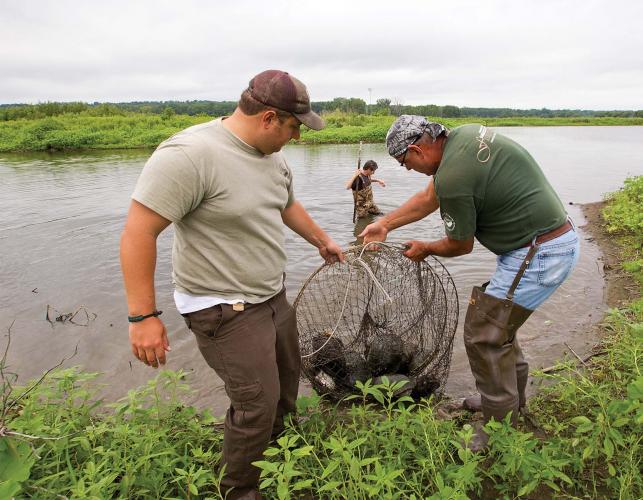
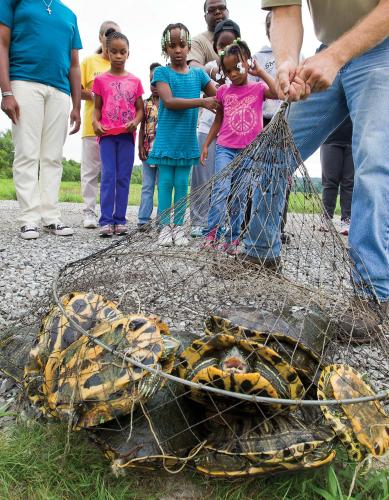
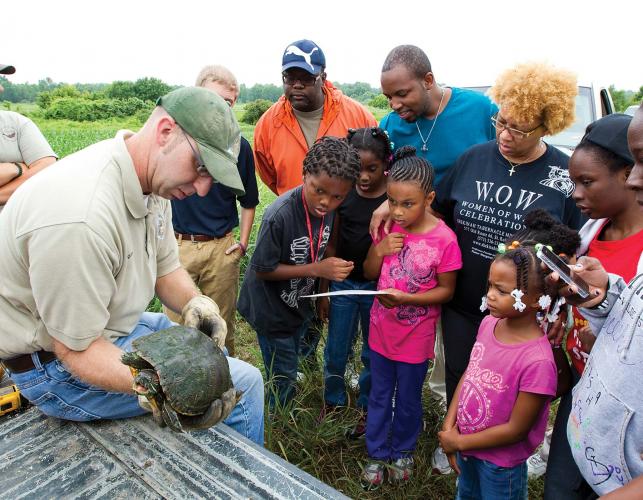
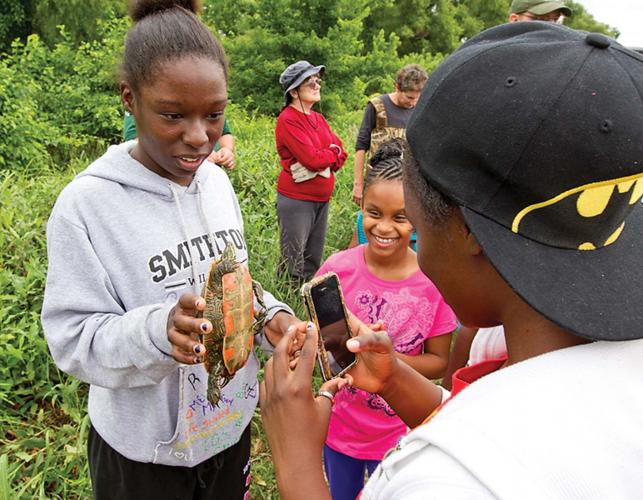
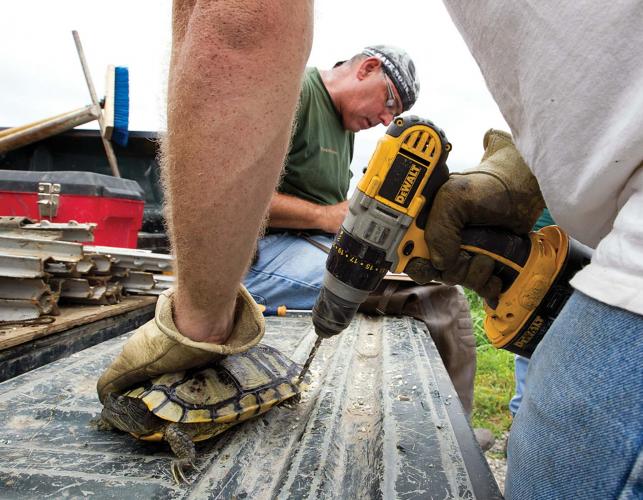






Also In This Issue


And More...
This Issue's Staff
Managing Editor - Nichole LeClair Terrill
Art Director - Cliff White
Staff Writer - Jim Low
Photographer - Noppadol Paothong
Photographer - David Stonner
Designer - Stephanie Thurber
Artist - Mark Raithel
Circulation - Laura Scheuler






















